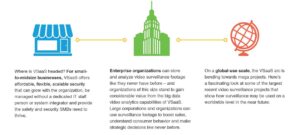
When deploying video surveillance, one of the first questions typically considered by the end user is whether to go with the on-premises (NVR) or cloud (VSaaS) architecture. To choose which one to deploy, an understanding of the pros and cons of each is required.
1. NVR
1.1. NVR pros
In an NVR architecture, most of the equipment needed for video surveillance is on the end user premises – these include cameras, a network video recorder (NVR) with server, video management and storage capabilities, and a network switch.
One advantage to this is the user can leverage their internal bandwidth resources and record in high resolution without any problem. The architecture is more straightforward as most of the equipment are link under local network.
The NVR architecture is completely owned by the customer, and its functionality does not rely on an Internet connection. This is particularly relevant for areas where connectivity is unreliable.
As a storage device, NVR can be directly deployed locally with the camera to form a single system in the LAN. It does not occupy public network bandwidth when the images are displayed in high-resolution mode.
Further, the user has complete control over their video surveillance settings. It will give more control to the end user in terms of operations and administration, and generally allows a richer user experience for the operators and system admins. You may also get deeper, native integrations for third-party hardware and software.
1.2. NVR cons
However, an NVR setup also has drawbacks. For starters, the cost of purchasing the on-premises equipment can be prohibitive for certain users. You’re looking at a much higher initial capital expenditure to deploy your system, and it involves more people and more time to install, configure and maintain. It is therefore a larger commitment and higher upfront cost.
The initial investment needed could outprice smaller companies. These organizations must also consider the knowledge and talent within the business, as solution maintenance and trouble-shooting must be done in-house.
Security is also a major issue with an NVR setup. There are three concerns with NVRs – theft, damage and recording breakdowns. When a business is burglarized, chances are the NVR is often stolen. And if there’s a fire, the recording device is often too damaged to be useful in determining whether it was set purposely and if so, who was the perpetrator.
NVR(s) can be subject to insider threats. In addition, a cyber breach of a company’s network could also contribute to a loss of recording and management, and the extraordinary costs of recovery and replacement.
Finally, the NVR architecture gives the user less flexibility to add or reduce cameras, and simultaneous viewing and access to footage tend to constrain the system. In an NVR setup, only a limited number of cameras can be connected. Performance is poor in general, especially when multiple users are attempting to use it at the same time; only a limited number of simultaneous viewers is allowed.
2. VSaaS
2.1. VSaaS pros
The disadvantages of the NVR architecture, then, bring out the benefits of VSaaS, which typically requires only the cameras as well as a network switch or router to forward the video to the Internet. As such, the initial cost of setting up video surveillance is much reduced.
There’s minimal hardware use, and VSaaS shifts the user to a predictable variable cost model, helping organizations leverage the solution’s cost efficiency to deliver better results.
There’s low or no installation and deployment cost, which typically means very low capital expenditure with higher ROI. Any enterprise or organization can set up the surveillance system without buying costly hardware. They would just need to connect the IP cameras to the VSaaS cloud applications, and the cost of storage would also be low compared to any NVR/DVR systems.

By removing the expense of purchasing servers, hard drives and camera licenses, end-users can expect to save up to tens of thousands on equipment that is likely to sit under someone’s desk or locked away in an electrical cupboard, thus allowing customers to invest that money into additional cameras or other aspects of their business .Cloud surveillance solution vendors consolidate the cost of administration, networking and energy consumption into the pay-as-you-go pricing. Because the compute-heavy hardware and software are in the cloud, you don’t need to worry about the support or maintenance. To read the rest of this article, wait for its second part to be published here.
Adapted from a&s Magazine



































































